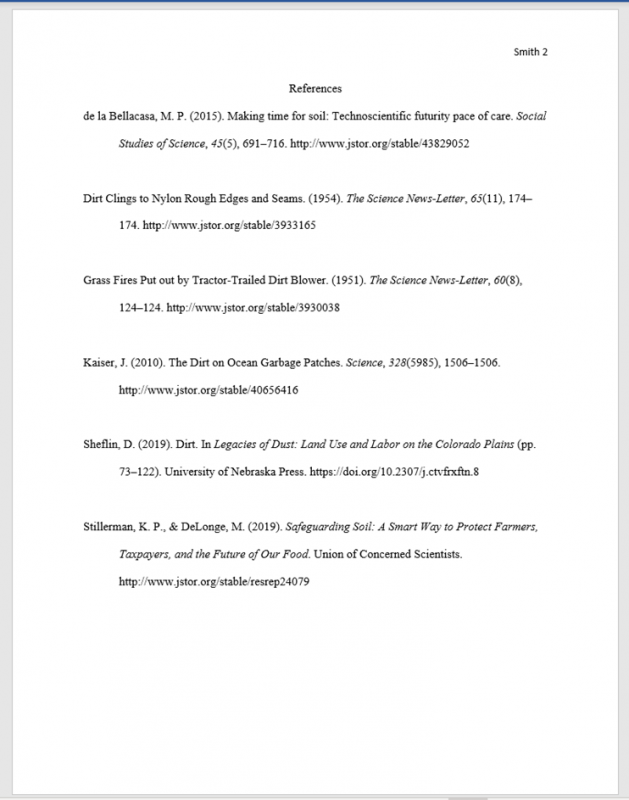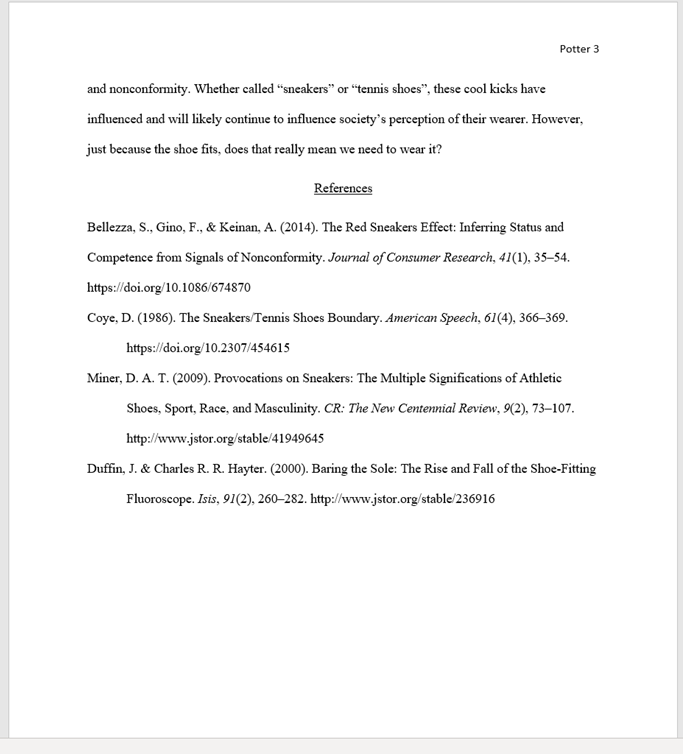As you write more advanced formal academic essays, you will need to include ideas from sources that you find through research. Learning ideas from other sources, connecting those ideas with your own ideas, and sharing your combined ideas with readers is one of the main purposes of academic writing. In order to show your readers where the ideas in your paper come from, you will need to include in-text citations and a list of information about each source you use.
Different Types of Source Lists
The expectations for how ideas are attributed to their sources vary around the world and for different fields of work or study. For more about how idea attribution is perceived around the world and in the American education system, see the Originality section of this textbook. In the U.S., you can use other people's ideas and even words in your writing, but you need to tell who the original sources of those ideas were.
How you do this is different by field of study. For example, a psychologist will use APA style to say the source was (Jones, 2010, p. 5), but a literary critic will use MLA style to say the source was (Jones 5). The source they used was the same, but the information about the source is shown in a slightly different style.
Some common styles include:
*Turabian style is a version of Chicago style.
This textbook teaches and uses APA style, so the source list is called a "reference page". In other styles, it may be called something else like a "works cited". The reference page is the list of sources written in APA style found at the end of your essay.
In-text Citations and Reference Pages Work Together
The reference page and in-text citations work together to show your reader where you found your ideas and more importantly where they can find the ideas themselves.
The reference page should include certain information like the author's name, publishing year, title, doi (a permanent website link), etc. The reader needs this information so they can go look up the source themselves to find out more. This listed information is called a citation. Sometimes it is called a full citation or reference. It is often too long to include in your essay's paragraphs though because it would interrupt readers from reading your regular writing, so it is put at the end of the paper.
Example Reference Page Citation
Barbier, E. B., & Cox, M. (2004). An Economic Analysis of Shrimp Farm Expansion and Mangrove Conversion in Thailand. Land Economics, 80(3), 389–407. https://doi.org/10.2307/3654728
Because the full citation is too long to put directly after the idea or words you used from the source, you will need to put an in-text citation instead. In-text citations are short versions of the information about the source that is written directly in the paragraphs of your essay. In-text citations are put in the essay right before or after the information you are citing to identify that information as being from another source for the readers.
Readers can then use that short version or mini citation to look up the rest of the information on the reference page. They can use the name, year, etc. to look up the full citation just as you would look up a word in a dictionary. Therefore, including matching in-text citations and reference page full citations is important.
Examples of In-Text Citation
(Barbier & Cox, 2004)
(Barbier & Cox, 2004, p. 390)
Basic Formatting Expectations
The reference page is called a "page" because it starts on its own page. You may need to click 'enter' or 'return' a few times if your essay's conclusion paragraph ends at the top or in the middle of a page. You should label the reference page with the title "References" in regular font at the top center of your reference page.
You will then list the sources you used in alphabetical order by the author's last name (Ie. Hatter, J. would come before Smith, T.). Use the last names (family names) of the authors followed by their first name initial. Some sources don't have a person author and may use an organization instead or may use no author at all. The entries should still be in alphabetical order by whatever the first word of the entry is. This can be seen in the example below where "Dirt..." comes before "Grass...".
These sources will need to be listed with a hanging indent. The hanging indent keeps the first line of the citation starting at the left like normal, but moves any other lines over a little to the right. This makes it easy for readers to see the author and year information to look up the source using the information from the in-text citation.
Example Reference Page

There are many more rules and expectations for the formatting of each entry in the listed sources. For more about that information and formatting see Appendix B: Using Sources. You will not be expected to memorize these rules; most people use tools to create the full citations for their reference pages rather than memorize the rules to make them.
Tools for Creating Citations
There are very few times that you would ever need to write a citation by hand without any resources to help. Almost always, you will instead be able to tools like manuals, resource websites, citation machines, or writing tutoring centers to help you.
Some types of sources are easy to cite such as a website with one author, a clear publishing date, a title, etc. However some sources are more difficult like a transcript of a radio interview or an article with three authors and an editor, but no publishing date. Your college professors won't expect you to memorize what to do in every possible situation, but they will expect you to be able to use your resources to create accurate citations for these many possible situations.
Resources and Tools for Citations
Manuals:
- Publication Manual of the American Psychological Association (7th edition)
Resource Websites:
Citation Machines:
Writing Tutoring Centers:
Each university or college has different tutoring resources available for their students. You can find these resources by asking your teacher, a librarian, or a college information desk for information.
The main tutoring resource for BYU is...
- Research and Writing Center located in the Harold B. Lee Library (HBLL 3340)
https://lib.byu.edu/services/research-and-writing-center/
Other:
Whenever you use a tool like an online citation maker, you should also use your own knowledge of APA to double-check that it is accurate. Online citation makers are not perfect. They may miss information or put information in ALL CAPS etc. It is up to you as the writer to make the final decisions about your citations and your reference page.
Exercises:
Exercise 1: Find Formatting Faults
Look at the reference page below. There are 5 mistakes on this reference page. Can you find them?

Exercise 2: Make a Reference Page
Use the sources below to make a reference page. You can use any of the tools for citation to help.
References:
Lorenz, M. (2005, January 28). What is Apa? Indiana University of Pennsylvania. Retrieved December 16, 2022, from https://www.iup.edu/writingcenter/writing-resources/research-and-documentation/apa-style/what-is-apa.html According to this website, "This guide for APA was adapted from: Hacker, D. (2003). A Writer' Reference. (5th ed.). Boston: St. Martin's. American Psychological Association. (2001). Publication Manual of the American Psychological Association. (5th ed.). Washington, DC: American Psychological Association."
Purdue OWL. (2022). MLA style Introduction. MLA Style Introduction - Purdue OWL® - Purdue University. Retrieved December 16, 2022, from https://owl.purdue.edu/owl/research_and_citation/mla_style/mla_style_introduction.html
University of Pittsburg Library System. (2022, October 11). Guides: Citation styles: APA, MLA, Chicago, Turabian, IEEE: Turabian 9th. Turabian 9th - Citation Styles: APA, MLA, Chicago, Turabian, IEEE - Guides at University of Pittsburgh. Retrieved December 16, 2022, from https://pitt.libguides.com/citationhelp/turabian
University of Washington Library. (2022, July 12). Library guides: Citation & writing guide: Chicago. Chicago - Citation & Writing Guide - Library Guides at University of Washington Libraries. Retrieved December 16, 2022, from https://guides.lib.uw.edu/c.php?g=344197&p=2318401